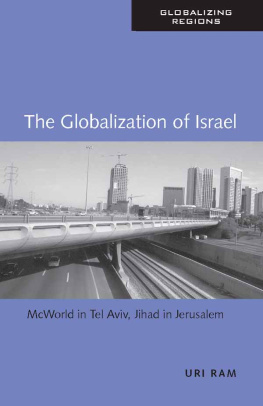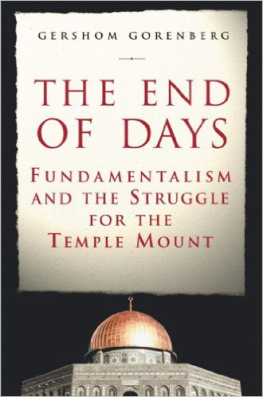This book made available by the Internet Archive.
To my sisters, Paula and Debbie, whom I miss every day
A Note on Terms
In order to assist the English-speaking reader, the spelling of Arabic terms throughout this book has been based on common usage in the United States and the United Kingdom (i.e., spellings commonly used by major newspapers and government agencies), and not on formal transliteration of literary Arabic. Additionally, Arabic terms that have been incorporated into standard American dictionaries have not been italicized. Common usage has also guided the rendering of Hebrew terms throughout the text rather than the formal rule of transliteration.
In keeping with the current usage by scholars and historians, this book will identify dates with the terms BCE (Before the Common Era) and CE (Common Era), rather than the more familiar BC and AD. These expressions correspond to the same period.
Introduction
The Battle for Historical Truth
Jerusalem was almost lost in July 2000, when the future of its ancient Old City was first put on the negotiating table. President Bill Clinton convened what would become a fifteen-day marathon summit at Camp David to fully resolve, once and for all, the Israeli-Palestinian conflict. Israelis and Palestinians were sealed off in the presidential retreat in Maryland and pressured to hammer out a final agreement. The whole event was a political long shot. Relations between the leaders, Israeli prime minister Ehud Barak and PLO chairman Yasser Arafat, were close to hostile and the pre-summit preparation was poor. 1 Nevertheless, Barak agreed to a stunning proposal: Israel would cede to the Palestinians sovereignty over most of East Jerusalem's suburbs, sovereignty over the Old City's Muslim and Christian quarters, and "custodianship" over Judaism's holiest site, the Temple Mount. 2 Since the Israel Defense Forces had captured Jerusalem's Old City in the Six-Day War in June 1967, no Israeli prime minister had proposed redividing the city. Now it was happening.
Barak's willingness to partition the Old City was especially astounding, as this was the spiritual heart of Israel's capital. A walled enclave located just inside the former border designating the eastern half of the
city, the Old City occupies just over half a square mile and is divided into Jewish, Muslim, Christian, and Armenian quarters. It is home to some of the holiest sites of the world's three major Abrahamic religions. The Temple Mount is the most sensitive location. A hilltop platform complex, the thirty-five-acre Temple Mount is the former location of the biblical First Temple (the Temple of Solomon), which stood from the tenth century BCE until its destruction by the Babylonians in 586 BCE. The Second Temple was constructed on the same site and stood from 515 BCE until the Romans demolished it in 70 CE. The Temple Mount is now largely off-limits for organized Jewish prayer, which instead is conducted at the Western Wall, a retaining wall from the Second Temple located adjacent to and just below the Temple Mount.
The Temple Mount is also the third holiest site to Muslims, who refer to it as Haram al-Sharif (the Noble Sanctuary). It is now home to two major Islamic shrines. The first of these, the Dome of the Rock, built in the late seventh century, houses the rock from which Muhammad is said to have ascended to heaven to receive the commandment for Muslim prayers. The second site is the al-Aqsa Mosque, the largest mosque in Jerusalem, completed in the early eighth century. Not far from the Temple Mount, in the Christian quarter, stands the Church of the Holy Sepulchre. It was originally built by the Roman emperor Constantine in the fourth century at Golgotha, the site where Jesus was crucified. The church is venerated by Christians as the location of Jesus's tomb and is a major site for Christian pilgrimage.
When Barak was proposing the city's redivision at Camp David, most Israelis still remembered that after seizing East Jerusalem in 1948, Jordan's Arab Legion completely evicted the Jewish population from the Old City. The Jewish Quarter was set aflame, its homes were looted, and dozens of synagogues were destroyed or vandalized. Tombstones from the ancient Jewish cemetery on the Mount of Olives were converted into latrines. For the following nineteen years, Jews were prevented from praying at their holy sites, including the Western Wall. The Jordanians also barred Christian institutions from buying land and otherwise restricted the rights of Jerusalem's Christian population, which dropped by over 50 percent
during the period of Jordanian rule. Upon capturing the Old City in 1967, Israel decided on a new approach to governing the cityit adopted a law protecting the holy sites of all religions and guaranteeing their free access to all worshipers. 3
Barak's mentor, the late Israeli prime minister Yitzhak Rabin, had declared in October 1995 that Jerusalem must always remain the united capital of Israel. He proclaimed this during his very last parliamentary speech, one month before his assassination. Rabin was born in Jerusalem and had commanded the victorious Israeli forces that unified the city in 1967. He understood that only Israel could safeguard Jerusalem's freedom. Enjoying bipartisan support in Washington for years, Rabin's position on a united Jerusalem was endorsed by the U.S. Senate in 1995 in the Jerusalem Embassy Act, which passed by an overwhelming 93-5 vote. Its co-sponsors included both parties' senatorial leaders, Republican Bob Dole and Democrat Tom Daschletwo politicians who agreed on little else. Jerusalem looked like a closed issue. Yet now with the Camp David proposals, Arafat suddenly had over half of Jerusalem's Old City within his grasp.
Barak was playing a dangerous diplomatic chess game with Rabin's legacy and with the history of his own people. His offer to Arafat is inexplicable in light of his advance knowledge, gleaned from his military intelligence chiefs, that Arafat had no intention whatsoever of making peace. Additionally, the threat of violence hung in the air. Sandy Berger, Clinton's national security advisor, had warned in a Tel Aviv speech two months before Camp David that failure to advance the peace process would probably lead to an armed confrontation; indeed, while Berger was speaking, skirmishes between armed Palestinians and Israeli soldiers had already broken out. Furthermore, Arafat's agents for psychological warfare were running summer camps where, according to the New York Times, tens of thousands of Palestinian teenagers were "learning the arts of kidnapping, ambushing and using assault weapons." 4 The environment was hardly conducive to making peace.

















